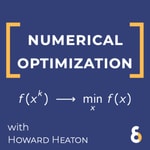Numerical Optimization – Details, episodes & analysis
Podcast details
Technical and general information from the podcast's RSS feed.


Recent rankings
Latest chart positions across Apple Podcasts and Spotify rankings.
Apple Podcasts
🇺🇸 USA - mathematics
14/08/2025#95🇺🇸 USA - mathematics
13/08/2025#94🇺🇸 USA - mathematics
12/08/2025#94🇺🇸 USA - mathematics
11/08/2025#94🇺🇸 USA - mathematics
10/08/2025#93🇺🇸 USA - mathematics
09/08/2025#90🇺🇸 USA - mathematics
08/08/2025#90🇺🇸 USA - mathematics
07/08/2025#91🇺🇸 USA - mathematics
06/08/2025#90🇺🇸 USA - mathematics
05/08/2025#87
Spotify
No recent rankings available
Shared links between episodes and podcasts
Links found in episode descriptions and other podcasts that share them.
See allRSS feed quality and score
Technical evaluation of the podcast's RSS feed quality and structure.
See allScore global : 43%
Publication history
Monthly episode publishing history over the past years.
Welcome to Numerical Optimization
vendredi 15 novembre 2024 • Duration 01:00
Our mission is to inspire the development of new math research aimed at solving real-world problems. We do this by sharing fun stories behind math formulas and the places they show up.
#1 — Stanley Osher
Episode 1
lundi 25 novembre 2024 • Duration 30:27
Stanley Osher is a mathematician at University of California Los Angeles.
Subscribe for updates and related optimization articles at
Show Notes:
Here is the original paper on total variation for denoising.
Here is a talk from 2003 where Stan describes and shows images from the attack on the truck driver Reginald Denny during the riots in LA (skip to 11:00 for the story).
Here is the paper on the level set method.
The company Stan cofounded, Luminescent Technologies, Inc, used the level set method for inverse lithography technology.
Here is a paper by Candes, Romberg and Tao on compressed sensing, providing rigorous theory for use of the L1 norm.
An example of "thinking continuously rather than discretely" is the analysis of Su, Boyd, and Candes in providing a short and simple proof for Nesterov acceleration in the continuous setting via a continuous ODE (see Theorem 3 in this paper).
